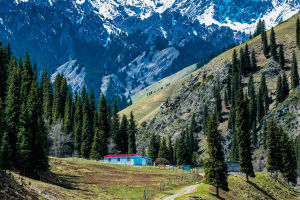The formation of salt lakes is dependent on specific natural conditions.
There are two critical factors to consider when looking at the formation of salt lakes: arid or semi-arid climate, and enclosed terrain with a certain amount of salt and water recharge.
Firstly, arid or semi-arid climatic conditions are essential for the formation of salt lakes. In these regions, the rate of evaporation of the lake often exceeds the rate of replenishment, leading to a continuous increase in the salt content.
This process results in various elements in the water reaching a saturated or supersaturated state, leading to the formation of different salt deposits on the lake shore and bottom.
For instance, the Qaidam Basin, located at an altitude of 2,600 to 3,200 meters and surrounded by a barrier of long stretches of mountains, is a typical inland desert basin.
Under the influence of the mid-latitude westerly circulation all year round, water vapor transport and precipitation there are scarce, making it an ideal place for the formation of salt lakes.
The Chaka Salt Pond at the north-eastern edge of the basin receives about 210mm of annual precipitation, while the Charkhan Salt Lake in the center of the basin receives only about 30mm of annual precipitation.
The evaporation here is much greater than the precipitation, and such climatic conditions are favorable for the formation of salt lakes.
In contrast, extremely dry climates with no rain or very little precipitation, like the interior of the Taklamakan Desert and Gurbantungut Desert in Xinjiang, are not conducive to the formation of salt lakes.
Salts are scattered, and it is difficult to form salt lakes in these areas due to a lack of surface runoff.
Secondly, enclosed terrain with a certain amount of salt and water recharge is essential to the formation of salt lakes.
Closed topography allows the runoff in the basin to converge to the lake, preventing the lake water from leaking out. This process allows for continuous transportation of salt from the basin to the lake through the runoff.
With strong evaporation, the lake water becomes saltier and saltier, leading to the formation of salt lakes over time.
In the Salt Lake area, a silvery-white band of salt around the lake can often be seen, resembling a beautiful collar worn on the salt lake.
This natural phenomenon is strong evidence of the migration of salt substances from the basin to the salt lake.
Various salts dissolved in the water body migrate from the basin to the salt lake, and as the water gradually evaporates, the concentration increases. Once saturation or supersaturation is reached, precipitation occurs.
However, due to the different solubility of the various salts, they show a certain sequence of precipitation, resulting in a clear ring-band pattern of distribution of various salt deposits from the upstream of the source of the material to the salt lake.
For example, in some salt lake areas at the northern foot of the Kunlun Mountains, boron salts are found near the mountains, and table salt and halite are deposited within the lake.
Salt lakes can also form from bays, and this process is called sea-forming salt lake evolution.
The average salt content of the vast ocean is 35 grams per liter of water. If a bay is isolated from the sea by the gradual development and expansion of sand dams along the coast, and the climate is dry and hot, the salinity of the water will continue to increase under the effect of strong evaporation, and eventually, a salt lake will be formed, producing deposits of various salts.
Salt lake formation is dependent on certain natural conditions. An arid or semi-arid climate, as well as enclosed terrain with a certain amount of salt and water recharge, are the critical factors that


